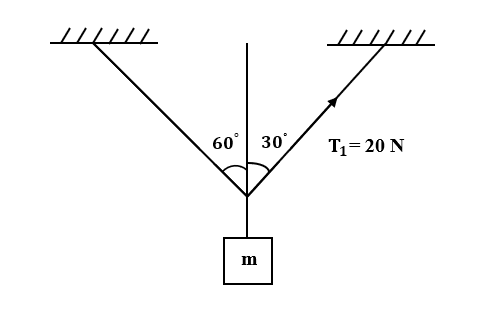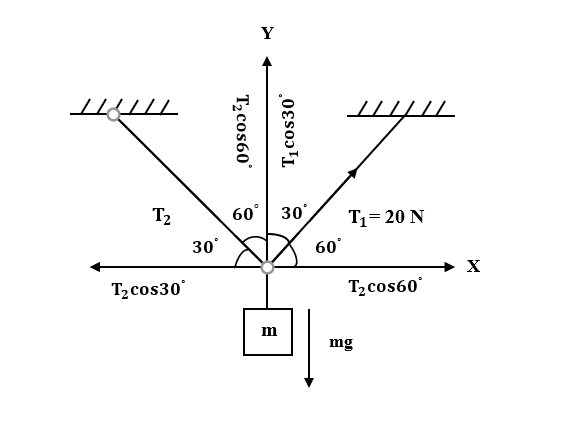
If the mass m is in equilibrium, the magnitude of m is $\left( g=10{ m }/{ { s }^{ 2 } } \right)$.

$A. 4 kg$
$B. 4 \sqrt {2} kg$
$C. \dfrac { 4 }{ \sqrt { 2 } } kg$
$D. \dfrac { 4 }{ \sqrt { 3 } } kg$

Answer
559.5k+ views
Hint: To solve this problem, first draw the free-body diagram and mention the forces along X and Y-axes. Then, equate the forces along the X-axis. Substitute the values and find the tension along another string i.e. ${T}_{2}$. Then, use the balanced forces along the Y-axis. Substitute all the given and obtained values in this expression and find the value of m which is mass. This obtained value will be the magnitude of m.
Complete step-by-step answer:

Given: ${T}_{1}= 20 N$
$g= 10{ m }/{ { s }^{ 2 }}$
In the figure drawn above, we can see on X-axis,
${ T }_{ 1 }\cos { { 60 }^{ ° }={ T }_{ 2 }\cos { { 30 }^{ ° } } }$
Substituting values in above equation we get,
$20\times \cfrac { 1 }{ 2 } ={ T }_{ 2 }\times \cfrac { \sqrt { 3 } }{ 2 }$
$\Rightarrow 20={ T }_{ 2 }\times \sqrt { 3 }$
$\Rightarrow { T }_{ 2 }=\dfrac { 20 }{ \sqrt { 3 } }$
Along Y-axis,
${ T }_{ 1 }\cos { { 30 }^{ ° }+{ T }_{ 2 }\cos { { 60 }^{ ° }=mg } }$
Substituting values in above equation we get,
$20\times \dfrac { \sqrt { 3 } }{ 2 } +\dfrac { 20 }{ \sqrt { 3 } } \times \dfrac { 1 }{ 2 } =m\times 10$
$\Rightarrow \dfrac { 20 }{ 2 } \left( \sqrt { 3 } +\dfrac { 1 }{ \sqrt { 3 } } \right) =m\times 10$
$\Rightarrow \left( \sqrt { 3 } +\dfrac { 1 }{ \sqrt { 3 } } \right) =m$
$\Rightarrow m=\dfrac { 4 }{ \sqrt { 3 } } kg$
Thus, the magnitude of m is $\dfrac { 4 }{ \sqrt { 3 } } kg$.
So, the correct answer is option D i.e. $\dfrac { 4 }{ \sqrt { 3 } } kg$.
So, the correct answer is “Option D”.
Note: To solve these types of questions, students must draw the free body diagram first. To draw a free body diagram, students must have a clear knowledge of free body diagrams. The diagrams used to represent forces and analyze them are called free body diagrams. These are pictorial representations of all the forces acting on the body due to contact with other objects or body objects acting on the body (such as gravity). These diagrams help us to understand the magnitude and direction of forces.
Complete step-by-step answer:

Given: ${T}_{1}= 20 N$
$g= 10{ m }/{ { s }^{ 2 }}$
In the figure drawn above, we can see on X-axis,
${ T }_{ 1 }\cos { { 60 }^{ ° }={ T }_{ 2 }\cos { { 30 }^{ ° } } }$
Substituting values in above equation we get,
$20\times \cfrac { 1 }{ 2 } ={ T }_{ 2 }\times \cfrac { \sqrt { 3 } }{ 2 }$
$\Rightarrow 20={ T }_{ 2 }\times \sqrt { 3 }$
$\Rightarrow { T }_{ 2 }=\dfrac { 20 }{ \sqrt { 3 } }$
Along Y-axis,
${ T }_{ 1 }\cos { { 30 }^{ ° }+{ T }_{ 2 }\cos { { 60 }^{ ° }=mg } }$
Substituting values in above equation we get,
$20\times \dfrac { \sqrt { 3 } }{ 2 } +\dfrac { 20 }{ \sqrt { 3 } } \times \dfrac { 1 }{ 2 } =m\times 10$
$\Rightarrow \dfrac { 20 }{ 2 } \left( \sqrt { 3 } +\dfrac { 1 }{ \sqrt { 3 } } \right) =m\times 10$
$\Rightarrow \left( \sqrt { 3 } +\dfrac { 1 }{ \sqrt { 3 } } \right) =m$
$\Rightarrow m=\dfrac { 4 }{ \sqrt { 3 } } kg$
Thus, the magnitude of m is $\dfrac { 4 }{ \sqrt { 3 } } kg$.
So, the correct answer is option D i.e. $\dfrac { 4 }{ \sqrt { 3 } } kg$.
So, the correct answer is “Option D”.
Note: To solve these types of questions, students must draw the free body diagram first. To draw a free body diagram, students must have a clear knowledge of free body diagrams. The diagrams used to represent forces and analyze them are called free body diagrams. These are pictorial representations of all the forces acting on the body due to contact with other objects or body objects acting on the body (such as gravity). These diagrams help us to understand the magnitude and direction of forces.
Recently Updated Pages
Master Class 11 Economics: Engaging Questions & Answers for Success

Master Class 11 English: Engaging Questions & Answers for Success

Master Class 11 Social Science: Engaging Questions & Answers for Success

Master Class 11 Biology: Engaging Questions & Answers for Success

Class 11 Question and Answer - Your Ultimate Solutions Guide

Master Class 11 Business Studies: Engaging Questions & Answers for Success

Trending doubts
What is meant by exothermic and endothermic reactions class 11 chemistry CBSE

10 examples of friction in our daily life

One Metric ton is equal to kg A 10000 B 1000 C 100 class 11 physics CBSE

Difference Between Prokaryotic Cells and Eukaryotic Cells

What are Quantum numbers Explain the quantum number class 11 chemistry CBSE

1 Quintal is equal to a 110 kg b 10 kg c 100kg d 1000 class 11 physics CBSE




